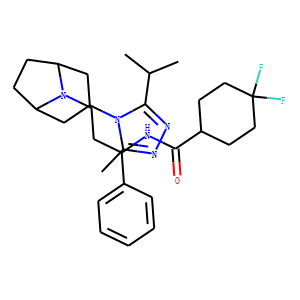| Reference | 1. Antivir Ther. 2009;14(5):607-18.<br />
Maraviroc: pharmacokinetics and drug interactions.<br />
Abel S(1), Back DJ, Vourvahis M.<br />
Author information:<br />
(1)Pfizer Global Research and Development, Sandwich, UK.<br />
Maraviroc is a potent selective CCR5 antagonist and is the first of this new class of oral agents to be approved for the treatment of CCR5-tropic HIV type-1. Maraviroc is extensively metabolized by CYP3A4, with renal clearance accounting for approximately 23% of total clearance. The half-life of maraviroc is approximately 16 h. Maraviroc does not inhibit any of the major CYP450 enzymes at clinically relevant doses and it has not shown any clinically relevant effects on plasma concentrations of other agents; hence, no dose adjustments of coadministered agents are required. Maraviroc exposure is altered by agents that modulate the activity of CYP3A4 and, in some circumstances, maraviroc dose adjustment is necessary. This article aims to review all pharmacokinetic and drug interaction data available for maraviroc, and to provide a comprehensive summary of the dose adjustment recommendations for maraviroc when coadministered with agents from all classes of antiretroviral therapy as well as other commonly coadministered agents. 2. Clin Ther. 2008 Jul;30(7):1228-50.<br />
Maraviroc: a CCR5-receptor antagonist for the treatment of HIV-1 infection.<br />
Lieberman-Blum SS(1), Fung HB, Bandres JC.<br />
Author information:<br />
(1)Pharmacy Service, James J. Peters Veterans Affairs Medical Center, Bronx, New York 10468, USA.<br />
BACKGROUND: The emergence of viral resistance is one of the greatest challenges in the treatment of HIV infection. Maraviroc is the first member of a new class of antiretroviral medications, the CCR5-receptor antagonists. It is approved by the US Food and Drug Administration (FDA) for use in combination with other antiretroviral agents in treatment-experienced patients infected with multidrug-resistant, CCR5-tropic HIV-1.<br />
OBJECTIVE: This article provides an overview of the pharmacology, efficacy, and tolerability of maraviroc in the treatment of HIV-1 infection.<br />
METHODS: Relevant information was identified through a search of MEDLINE (January 2000-May 2008) using the terms maraviroc, UK-427,857, and CCR5-receptor antagonist. Also consulted were abstracts from the International AIDS Society Conference, the Conference on Retroviruses and Opportunistic Infections, and other relevant scientific meetings. Additional publications were found by searching the reference lists of the identified articles and the FDA Web site. RESULTS: Maraviroc is a selective, reversible, small-molecule CCR5-receptor antagonist. In vitro, it has potent anti-HIV-1 activity, with a mean 90% inhibitory concentration of 2.0 nmol/L. It is widely distributed, with a V(d) of approximately 194 L. Maraviroc is moderately metabolized in the liver (65.3%), primarily via the cytochrome P450 3A4 isozyme. It has an elimination t(1/2) of 15.9 to 22.9 hours. Until more data are available, maraviroc should be avoided in patients with severe hepatic insufficiency; dose adjustment does not appear to be necessary on the basis of age, sex, or renal function. In 2 Phase IIb/III studies, maraviroc 300 mg PO QD or BID was found to be more efficacious than placebo in reducing the viral load at 48 weeks in treatment-experienced, CCR5-tropic HIV-1-infected patients receiving an optimized background regimen (difference vs placebo-QD arm: -0.89 log(10) copies/mL [97.5% CI, -1.17 to -0.62]; BID arm: -1.05 log(10) copies/mL [97.5% CI, -1.33 to -0.78]). The proportion of patients with a viral load < 50 copies/mL was 43.2% in the QD arm and 45.5% in the BID arm, compared with 16.7% in the placebo arm (P < 0.001, both treatment arms vs placebo). In treatment-naive patients infected with CCR5-tropic virus only, maraviroc 300 mg PO BID was not noninferior to oral efavirenz 600 mg QD (difference = -4.2%; lower bound of the 1-sided 97.5% CI, -10.9 [predefined statistical cutoff for noninferiority, -10]). Maraviroc was generally well tolerated in clinical trials. The most frequently reported (> or = 5%) adverse events were upper respiratory tract infection (20.0%), cough (12.7%), pyrexia (12.0%), rash (9.6%), musculoskeletal complaints (8.7%), gastrointestinal and abdominal pain (8.2%), dizziness (8.2%), appetite disorders (7.3%), insomnia (7.0%), herpes infection (6.8%), sinusitis (6.3%), joint complaints (6.1%), bronchitis (5.9%), and constipation (5.4%). The recommended dose of maraviroc differs based on concomitant medications, ranging from 150 to 600 mg BID. CONCLUSION: When used in combination with other antiretroviral agents, maraviroc appears to be a promising agent for treatment-experienced patients infected with multidrug-resistant, CCR5-tropic HIV-1.<br />
3. Curr Opin Investig Drugs. 2007 Aug;8(8):669-81.<br />
Maraviroc, a chemokine CCR5 receptor antagonist for the treatment of HIV infection and AIDS.<br />
Meanwell NA(1), Kadow JF.<br />
Author information:<br />
(1)Bristol-Myers Squibb Research and Development, 5 Research Parkway, Wallingford, CT 06492, USA. [email protected]<br />
Pfizer Inc is developing maraviroc, a CCR5 receptor antagonist for the treatment of HIV-1 infection and rheumatoid arthritis. In April 2007, the FDA advisory committee voted to approve maraviroc for HIV-1 infection. Phase II and III clinical trials, and post-approval studies are ongoing in both treatment-experienced and -naive HIV patients. Phase II trials have also been initiated in patients with rheumatoid arthritis.<br />
|

